(5) Cooperation in Disaster Risk Reduction and Emergency Assistance in the Event of Disaster
Disasters caused by earthquakes, tsunamis, typhoons, floods, debris flows, and other natural events that occur frequently around the world do not merely take human lives and property. In developing countries that are vulnerable to disasters, the poor suffer from significant damage and become displaced in many cases. In addition, secondary damage such as the deterioration of sanitary conditions and food shortages may become protracted, making the problem more severe. In this respect, disasters have a significant impact on the overall social and economic mechanisms of developing countries.
Against this backdrop, it is necessary to build a disaster resilient society to protect human lives from disasters, as well as to promote the “mainstreaming of disaster reduction,” aiming at sustainable development, by incorporating disaster risk reduction measures into every phase of every sector of development based on assumptions of disasters of various scales.
< Japan's Efforts >
| Cooperation in disaster risk reduction
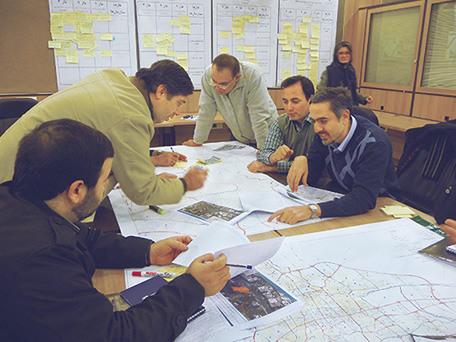
Conducting a Disaster Table Top Exercise in Teheran, Iran. (Photo: Katsu Kato / Oriental Consultants Global Co., Ltd.) See this, for more details of the project.
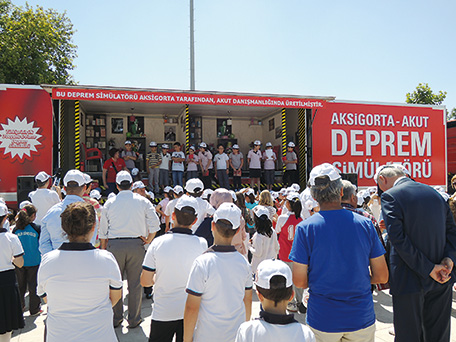
An educational event for disaster risk reduction was held in Sakarya City in Turkey, using an earthquake simulation vehicle of a private insurance company. Several thousands of children in the prefecture participated in the event. (Photo: Taichi Minamitani / JICA Turkey Office)
Japan utilizes its superior knowledge and technology acquired through past experiences of responding to natural disasters such as earthquakes and typhoons to provide proactive support in the fields of disaster prevention and post-disaster reconstruction, alongside emergency assistance. In 2005, at the Second UN World Conference on Disaster Reduction in Kobe, the Hyogo Framework for Action 2005-2015 was adopted as a basic guideline for disaster risk reduction activities in the international community, and the importance of effectively incorporating disaster risk reduction aspects into initiatives for sustainable development was confirmed. Japan partners with the United Nations and other organizations to promote its worldwide implementation.
At this conference, Japan also announced the “Initiative for Disaster Reduction through ODA,” which represents Japan's basic policy on disaster risk reduction cooperation. In this policy, Japan expressed its intention to continue proactively supporting the self-help efforts by developing countries towards building a disaster-resilient society through building of systems, human resources development, development of socio-economic infrastructure, and other measures.
On July 3 and 4, 2012, Japan hosted the World Ministerial Conference on Disaster Reduction in Tohoku in three prefectures afflicted by the Great East Japan Earthquake. During the conference, the following aspects were affirmed and the necessity of “Disaster Reduction in the 21st Century” as a comprehensive way to promote these aspects was proposed to the world: the necessity of mainstreaming disaster risk reduction and building resilient societies; the importance of human security; the need to maximize combining both structural and nonstructural disaster risk reduction capabilities; the necessity of collaboration beyond the roles of various stakeholders; the importance of responding to newly emerging disaster risks such as climate change and urbanization. Participants in the conference also confirmed the positioning of disaster risk reduction in the post-2015 development agenda, as well as the need for formulating the post-Hyogo Framework for Action that incorporates the results of this conference, in order to actually promote the“Disaster Reduction in the 21st Century.” Japan also pledged to provide $3 billion in three years from 2013 to 2015 to support initiatives in the disaster reduction field.
In March 2015, the Third UN World Conference on Disaster Risk Reduction will be held in Sendai City, Japan. The successor framework of the-Hyogo Framework for Action 2005- 2015 will be formulated during this conference, and Japan intends to contribute to the mainstreaming of disaster risk reduction through the discussions on this issue.
| Japan's Emergency and Humanitarian Assistance
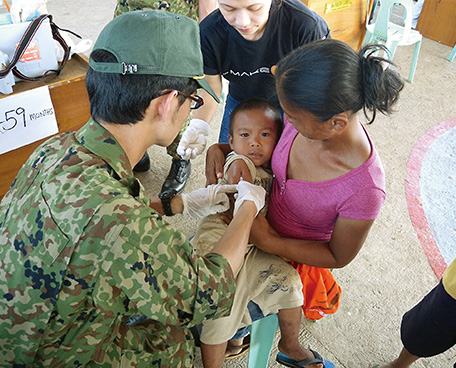
Japan Self-Defense Forces medical team providing medical treatment in Daanbantayan on Cebu Island, in response to the typhoon Haiyan (Yolanda) disaster in November 2013. (Photo: Ministry of Defense)
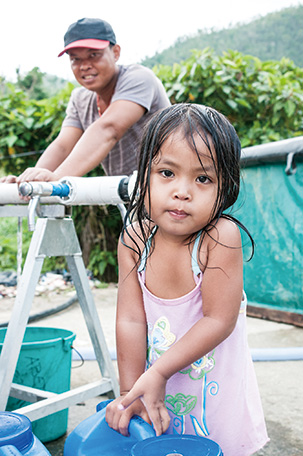
A girl collecting water from a communal tap in a temporary housing area in Tacloban, Leyte Province in the Philippines. (Photo: Mika Tanimoto / JICA)
Japan stands ready for immediate provision of emergency assistance in response to requests from the government of an affected country or an international organization when a large-scale disaster occurs overseas. Japan has four types of Japan Disaster Relief (JDR) Teams to provide humanitarian assistance: (i) Search and Rescue Team to search and rescue victims; (ii) Medical Team to provide urgent medical assistance; (iii) Expert Team to give technical advice or guidance on emergency response measures and recovery operations; and (iv) Self-Defense Force Unit to provide emergency assistance, such as medical activities and transportation when it is deemed particularly necessary in response to a large-scale disaster, etc.
In-kind assistance includes the provision of Emergency Relief Goods. Japan stockpiles tents, blankets, and other goods at overseas warehouses in five locations at all time, which enables Japan to be prepared to swiftly provide relief goods to affected countries when a disaster occurs.
Moreover, with the aim to provide relief to displaced persons or people affected by natural disasters and/or conflicts, Japan extends Emergency Grant Aid for the governments of affected countries as well as the International Red Cross, which provides emergency assistance in areas affected by the disasters.
In FY2013, Japan provided Emergency Relief Goods on a total of 16 occasions to 15 countries, including the Philippines, Myanmar, South Sudan, and Bolivia.
Regarding the Emergency Grant Aid, Japan provided approximately ¥7.9 billion in FY2013 as emergency disaster assistance to a total of eight countries, including India and the Philippines, in order to provide support for the people affected by natural disasters, as well as Syrian refugees and internally displaced persons. For example, for Syrian refugees and internally displaced persons, Japan contributed a total of $35 million through international organizations to provide assistance in the areas of food and relief supplies, water and sanitation, and other areas.
In response to the typhoon disaster that hit the central Philippines in November 2013, Japan provided approximately ¥60 million worth of emergency relief supplies (such as plastic sheets) and $30 million (approximately ¥3 billion) in Emergency Grant Aid. In addition, Japan deployed JDR Medical Teams, Expert Teams (experts of early recovery and oil-spill prevention), and Self-Defense Force Units. The dispatched Self-Defense Force Units consisted of approximately 1,100 personnel, the largest ever, and it conducted activities such as medical assistance, epidemic prevention, and transportation of affected-people and relief goods.
For the search and rescue operations implemented in response to the disappearance of a Malaysia Airlines plane in March 2014, a search aircraft of the Japan Coast Guard and four Self-Defense Force aircraft were dispatched and participated in the international search and rescue operations.
| Collaboration with International Organizations
Japan cooperates with the “Global Facility for Disaster Reduction and Recovery” established in 2006 and managed by the World Bank. This Facility aims at supporting efforts to improve the ability for disaster risk prevention planning and post-disaster reconstruction in low- and middle-income countries that are vulnerable to natural disasters.
Against the backdrop of increased awareness of the importance of disaster risk reduction, representatives from countries all over the world and from international organizations such as the World Bank and UN bodies, which are involved in disaster risk reduction, gathered at a meeting of the UN General Assembly in 2006. At the meeting, the decision was made on the establishment of the “Global Platform for Disaster Risk Reduction” as a forum to facilitate discussions regarding disaster risk reduction. The first meeting of the Global Platform was held in June 2007. Japan proactively supports the activities of the Secretariat of the UN International Strategy for Disaster Reduction (UNISDR), which serves as the secretariat for the Global Platform. In October 2007, the Hyogo Office of the UNISDR was opened.
In May 2013, the fourth session of the Global Platform for Disaster Risk Reduction was held in Geneva, Switzerland. More than 3,500 delegates representing 172 governments, NGOs and private organizations participated in the meeting. Japan announced that it would host the Third UN World Conference on Disaster Risk Reduction in Sendai City, Japan.
Eight years have passed since the Second World Conference on Disaster Reduction in Kobe, and Japan has been proactively engaged in the follow-up efforts on the Hyogo Framework for Action, which serves as the basic guideline for disaster risk reduction activities in the international community, while also utilizing the forums provided by meetings of the Global Platform.
In addition, Japan is also supporting the ASEAN Coordinating Centre for Humanitarian Assistance on Disaster Management (AHA Centre) by providing communication equipment and dispatching personnel as well as providing emergency relief goods and support for establishing a goods management and distribution system.
| The Philippines
The Project on Rehabilitation and Recovery from Typhoon Yolanda
Technical Cooperation for Development Planning (January 2014 – Ongoing)
The Programme for Rehabilitation and Recovery from Typhoon Yolanda
Grant Aid (May 2014 – Ongoing)
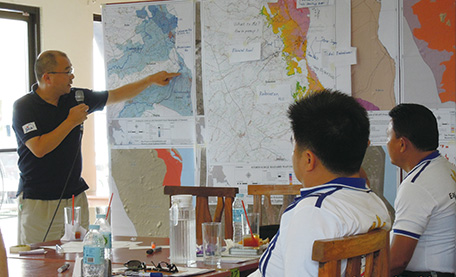
A survey team personnel explaining the concept of land usage to the city officials, using a hazard map created by the Japanese survey team during a reconstruction planning workshop. (Photo: JICA)
Typhoon No. 30 (known as Typhoon Yolanda in the Philippines) directly hit the Philippines on November 8, 2013, causing enormous damage in its 36 states. The typhoon swept across the Philippines, mainly the Visayas region in the central Philippines. The typhoon was of an unprecedented force in recorded history, with a maximum wind speed of 87.5 m/s and a maximum instantaneous wind velocity of 105 m/s. It killed over 6,000 people, damaged over 1 million houses, and displaced over 4 million people. A large area was affected, including many cities and towns. In particular, the typhoon caused catastrophic damage in areas where many poor people live, such as the east coast of northern Leyte Island and the south coast of Samar Island. The Philippines' major industries including coconut farming and fisheries were hit hard, making it uncertain whether the people living there can make a living over the next several years.
In the wake of this situation, Japan conducted emergency relief operations, such as dispatching the Japan Disaster Relief (JDR) Team in the immediate aftermath of the disaster. Subsequently, in the recovery phase, Japan has been providing grant aid to help re-build damaged primary schools and hospitals, establish measures to secure the means of livelihood of the victims, and restore public infrastructure such as airports and local government offices.
Furthermore, in order to support the Philippines' rehabilitation in the mid- to long-term and to provide seamless cooperation, the implementation of Technical Cooperation for Development Planning was decided. This project provides comprehensive support for a series of processes aimed at the early recovery and rehabilitation of the affected areas and the building of a society and communities that are more resilient to disasters, while referring to Japan's experience with disasters and lessons learned on disaster risk reduction and recovery efforts. In addition to providing support for the formulation of a rehabilitation and recovery plan, Japan will support the rehabilitation and recovery efforts of the Government of the Philippines, under the assumption that the interim results of the aforementioned project will contribute to subsequent grant aid and ODA loan programs.
(As of August 2014)
| Iran
Capacity Building for Earthquake Risk Reduction and Disaster Management in Tehran
Technical Cooperation Project (April 2012 – Ongoing)
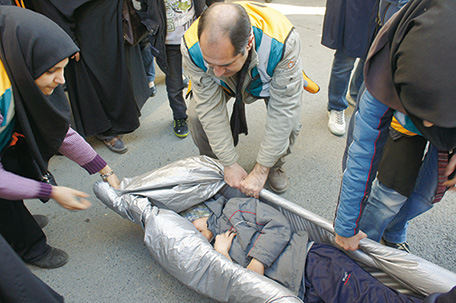
A scene from lifesaving training to respond to disaster. (Photo: Ryoji Takahashi / Oriental Consultants Global Co., Ltd.)
Tehran, the capital city of Iran, is located in an active seismic belt. Major earthquakes have occurred in around 150-year cycles, striking in 1665 and then in 1830. However, with no major earthquakes striking Tehran in the last 185 years, people have become less conscious about disaster preparedness. In addition, urbanization has proceeded at a rapid pace without implementing appropriate disaster risk reduction measures, raising concerns that if a large-scale earthquake were to hit the city, it could result in an unprecedented catastrophe.
Against this background, Japan has been providing assistance to Tehran with the aim of projecting the possible extent of damages if earthquakes were occur, formulating a master plan, and developing a plan for the initial response after an earthquake, among other activities. Through this project, Japan provides support for building up the capacities of the Tehran Disaster Mitigation & Management Organization (TDMMO) related to the road disaster risk reduction plan, the community-based disaster risk reduction plan, and the establishment and operation of an early warning system. It is expected that the project will enhance the capabilities of the city of Tehran in three areas, which are road disaster risk reduction, public outreach (disaster risk reduction education), and early warning, in order to deal with earthquake disasters.
Notably, Japan shared with the TDMMO and those involved in disaster risk reduction not only related technologies but also lessons learned and its experience with previous large-scale earthquakes, including the Great Hanshin-Awaji Earthquake (1995) and the Great East Japan Earthquake (2011). Through such initiatives, the project aims to raise disaster risk reduction awareness among the government and citizens, minimize damage from disasters as much as possible, as well as create a disaster-resilient city where the government and local government can take immediate emergency responses following a disaster.
(As of August 2014)
